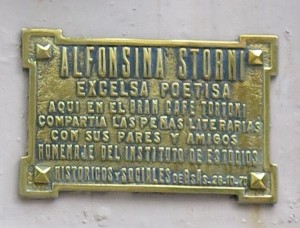Tango ist eine Dreifaltigkeit aus Musik, Poesie und Tanz. Das ist eine Wahrheit, die jeder Tangoliebhaber früher oder später lernen wird. Tango als Musik ist laut und ausdrucksstark, Tango als Tanz variabel zwischen eindrucksvoll und ausdrucksstark, und die Poesie im Tango ist meist sehr beeindruckend und für den typischen nicht spanischsprachigen Tanguero außerhalb Lateinamerikas kaum wahrnehmbar.
Heute möchte ich über diese Seele des Tangos sprechen. In einer Milonga kommt es manchmal vor, dass die Leute genug Pugliese, Neotango oder was auch immer sie möchten, haben und sehr müde sind. Als DJ reagiere ich auf diese Situation, indem ich langsame, gemütliche Musik spiele, bei der die Leute sich entspannen und Energie für die abschließenden Tandas sammeln können. Eines der Lieder, die hier manchmal gespielt werden, ist „Alfonsina y el mar“, das nach unserer Definition kein Tango-Lied ist. Dieses Lied ist fast jedem in Lateinamerika bekannt, und ich denke, ein gebildeter Tanguero sollte den Hintergrund und die Bedeutung dieses einzigartigen Musikstücks kennen.
Das Lied ist nach Alfonsina Storni benannt, einer sehr beliebten Dichterin und Journalistin. In Südamerika ist sie eine Legende, in Europa und Australien hingegen kennt sie kaum jemand. Sie wurde 1892 in der Schweiz geboren und zog 1901 mit ihrer Familie nach Rosario (Argentinien). 1907 schloss sie sich einer reisenden Theatergruppe an und trat als Schauspielerin auf [1]. Später arbeitete sie als Lehrerin und Journalistin, veröffentlichte aber auch Gedichte. Dabei wurde sie stark von ihrem engen Freund Horacio Quiroga beeinflusst. Alfonsina war eine Kämpferin für die Befreiung der Frau und den Feminismus im Allgemeinen und hatte eine sehr scharfe Zunge.

1935 wurde bei ihr Brustkrebs diagnostiziert. Sie wurde operiert und musste während der anschließenden Chemotherapie sehr leiden [2]. 1937 und 1938 begingen zwei ihrer besten Freunde, H. Quiroga und L. Lugones, Selbstmord. 1938 reiste sie nach Mar del Plata, schrieb ihr letztes Gedicht „Voy a dormir“ (Ich gehe schlafen), das sie an die Zeitung La Nación schickte, und beging am Strand von La Perla Selbstmord [1, 2]. Ihr Grab befindet sich auf dem Cementerio de Chacarita in Buenos Aires.
Betrachtet man dieses letzte Gedicht (entnommen aus [3]), wird die Tragik ihrer Situation deutlich:
Dientes de flores, cofia de rocío,
manos de hierbas, tú, nodriza fina,
tenme prestas las sábanas terrosas
y el edredón de musgos escardados.
Voy a dormir, nodriza mía, acuéstame.
Ponme una lámpara a la cabecera;
una constelación; la que te guste;
todas son buenas; bájala un poquito.
Déjame sola: oyes romper los brotes…
te acuna un pie celeste desde arriba
y un pájaro te traza unos compases
para que olvides… Gracias. Ah, un encargo:
si él llama nuevamente por teléfono
le dices que no insista, que he salido…
Hier ein grober Versuch einer Übersetzung ins Deutsche (aus [4]):
Blumenzähne, Tauhaarnetz,
Kräuterhände, du, vollkommene Amme,
bereite mir die irdischen Laken
und die Daunendecke aus Moos.
Ich gehe schlafen, meine Amme, bring mich ins Bett.
Stell eine Lampe an mein Kopfende;
ein Sternbild; was immer du willst;
alles ist gut: mach sie etwas dunkler.
Lass mich in Ruhe: Du hörst die Knospen aufbrechen …
Ein himmlischer Fuß wiegt dich von oben
und ein Vogel zeichnet ein Muster für dich,
damit du vergisst … Danke. Oh, eine Bitte:
Wenn er wieder anruft,
sag ihm, er soll es nicht weiter versuchen, denn ich bin gegangen …
Dies ist wirklich schönes und bedeutungsvolles Gedicht. Die Tragödie ihres Todes inspirierte den Historiker und Schriftsteller Felix „Falucho“ Luna zu dem Gedicht „Alfonsina y el mar“ (Alfonsina und das Meer, eine Ode an die unglückselige Dichterin Alfonsina Storni) [5]. Die Musik dazu schrieb Ariel Ramirez, „einer der bedeutendsten Vertreter der argentinischen Volksmusik“ [6]. Das Lied wurde 1969 von Mercedes Sosa für ihr Album „Mujeres Argentinas“ aufgeführt, was sie zu einer Ikone der argentinischen Folklore machte. Später wurde das Lied von über 40 anderen Musikern aufgeführt, darunter Placido Domingo, Nana Mouskouri und Shakira [7].
Dies ist die Originaldarbietung von Mercedes Sosa. Das Originallied ist kein Tango, sondern wird als Zamba gespielt. Normalerweise wird es mit einem Klavier als Zwischenstimme oder nur mit Gitarre gespielt. Hier sind zwei Beispiele (Mercedes Sosa hat dieses Lied in vielen Variationen aufgeführt):
http://www.youtube.com/watch?v=ZzhpTA95Bnc
http://www.youtube.com/watch?v=fpQvuquMhNY
Es ist sehr interessant, sich den Text genauer anzusehen. Hier sind daher der Originaltext in Spanisch und die englische Übersetzung [8]:
Por la blanda arena que lame el mar
su pequeña huella no vuelve más.
Un sendero solo de pena y silencio llegó
hasta el agua profunda.
Un sendero solo de penas mudas llegó
hasta la espuma.
Sabe Dios qué angustia te acompañó
qué dolores viejos calló tu voz,
para recostarte arrullada en el canto
de las caracolas marinas.
La canción que canta en el fondo oscuro
del mar, la caracola.
Te vas Alfonsina con tu soledad,
¿qué poemas nuevos fuiste a buscar?
Una voz antigua de viento y de sal
te requiebra el alma y la está llevando
y te vas hacia allá como en sueños,
dormida, Alfonsina, vestida de mar.
Cinco sirenitas te llevarán
por caminos de algas y de coral
y fosforescentes caballos marinos harán
una ronda a tu lado;
y los habitantes del agua
van a jugar pronto a tu lado.
Bájame la lámpara un poco más,
déjame que duerma, nodriza, en paz
y si llama él no le digas que estoy,
dile que Alfonsina no vuelve más,
y si llama él no le digas nunca que estoy,
di que me he ido.
Te vas Alfonsina con tu soledad,
¿qué poemas nuevos fuiste a buscar?
Una voz antigua de viento y de sal
te requiebra el alma y la está llevando
y te vas hacia allá como en sueños,
dormida, Alfonsina, vestida de mar.
———————————————————————————-
Across the soft sand that the waves lick
Her small footprints are not coming back anymore
Only one path made of sorrow and silence
Reached the deep water
Only one path made of untold sorrows
Reached the foam
Only God knows about the anguish that accompanied you
And about the old pains your voice never told
That caused you to go to sleep, lulled by the song
Of the seashells
The song sung in the depths of the dark sea by
The seashell
You’re going away, Alfonsina
Along with your loneliness
What kind of new poems did you go looking for?
An ancient voice made of wind and salt
Is shattering your soul and taking you away
And you go there, like in a dream
Asleep, Alfonsina, dressed with the sea
Five little mermaids will escort you
Through paths made of seaweed and corals
And phosphorescent sea horses will sing
A round, by your side
And the aquatic dwellers
Will soon play by your side
Dim the light of the lamp a bit for me
Let me sleep in peace, nurse
And if he calls don’t tell him I’m here
Tell him that Alfonsina is not coming back
And if he calls never tell him I’m here
Tell him that I have left
You’re going away, Alfonsina
Along with your loneliness
What kind of new poems did you go looking for?
An ancient voice made of wind and salt
Is shattering your soul and taking you away
And you go there, like in a dream
Asleep, Alfonsina, dressed with the sea
——————————————————————————–
Interessant ist hier der starke Bezug zu Stornis letztem Gedicht „voy a dormir“ im Absatz aus „Bájame la lámpara un poco más“.
Das Lied ist kein Tango, aber es gibt (mehr oder weniger) tanzbare Versionen. Mir persönlich gefällt die Version von Medialuna Tango Project [9]:
http://www.youtube.com/watch?v=ImuPefgLKOk
Die letzte Frage ist: Sollte man diese Musik zum Tanzen verwenden? Denken Sie daran, dass die Emotionen und die Verzweiflung dieses Liedes echt sind, auch wenn sie aus zweiter Hand stammen. Ich persönlich denke, Alfonsina würde sich sehr freuen, wenn Sie zu der Musik tanzen, vorausgesetzt, Sie erinnern sich beim Hören oder Tanzen ein wenig an sie.
Grüße aus meinem Urlaub im guten alten Deutschland,
-Richard
Literatur
1 http://en.wikipedia.org/wiki/Alfonsina_Storni
2 http://de.wikipedia.org/wiki/Alfonsina_Storni
3 http://www.los-poetas.com/j/storni1.htm#VOY%20A%20DORMIR
4 http://www.poemhunter.com/poem/i-am-going-to-sleep/
5 http://en.wikipedia.org/wiki/F%C3%A9lix_Luna
6 http://en.wikipedia.org/wiki/Ariel_Ram%C3%ADrez
7 http://es.wikipedia.org/wiki/Alfonsina_y_el_mar
8 http://lyricstranslate.com/en/alfonsina-y-el-mar-alfonsina-and-sea.html
9 http://www.amazon.de/gp/product/B002GUBJKC/ref=dm_att_alb7

